
|   |

|   |
18th Sangam Festival by Art Vision - Dr. Nita Vidyarthi e-mail: nitavidyarthi@gmail.com Photos courtesy: Ileana Citaristi November 6, 2022 The possibility of doing something that has not been done so far, even if in the conventional dancing mould, is necessarily an ambitious and illuminating effort to break away from the mundane. Acclaimed Odissi dancer Ileana Citaristi is one such virtuoso who for years together has been mounting uncommon productions like Karuna, Kaala, Sharanam, Meghadootam Refugee, Siddharth, Suta to name a few, that unleashes aesthetically with emotional introspection and empathy, the trials and tribulations of mankind in their journey of life by exploring perspectives on traditional realms of Odissi (blending sometimes with martial arts and folk elements). They span from social to literary work suffused with sensitive humane spirits. With a trained group of dancers of her institution Art Vision, she continues to explore these notions in dance in her annual Sangam Festival. The main aim of the Sangam festival is to showcase and share two different classical dance styles on one platform in the same evening by well-known guest artistes and their group side by side with classical Odissi by Art Vision. The 18th Sangam this year, presented well-known Bharatanatyam exponent Anuradha Vikranth and her Drishti Dance Ensemble, a popular performing unit of Drishti Dance Centre from Bangalore along with three items by Art Vision. 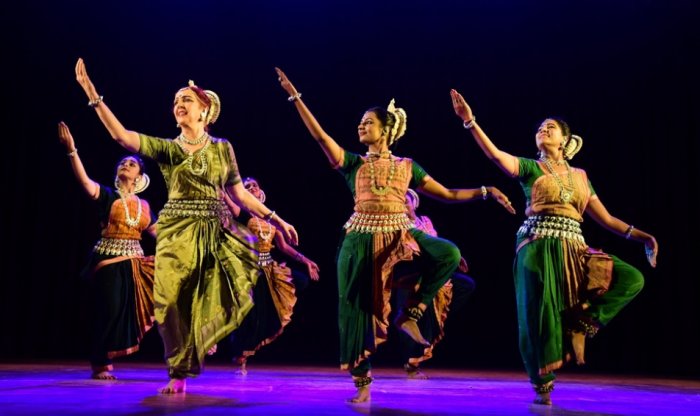 Ganga Nomami After the inauguration, the performances began with 'Ganga Nomami' based on the Ganga Stotram of Adi Shankaracharya in praise of the sacred river Ganges by Ileana and her repertory members. Fitted beautifully to the music of Rohan Dasgupta, Ileana showed commanding stage presence in her own inimitable way accompanied by five uniformly trained dancers. The choreography replete with lasya hand movements depicting waves and flow of the river in the short piece with Ileana in the lead was a delight to watch. The final frieze with the dancers positioned with a low angle of elevation was stunning. Sabdaswara Pata that followed was based on sabda nritya woven around four bhangis, Alasa, Manini, Taranga and Biraja featuring the lasya elements of Sabdaswara Pata composed by Guru Gajendra Panda. The choreography of this Pallavi by Ileana, the pure dance or nritta item, showed imagination in the lovely motifs, and was set to raga Ananda Kedar, Ektali with music by Ramesh Chandra Das and Surendra Maharana. The three dancers had a fine grip on rhythm, Alasa being the most appealing. This year's production of Ileana was different from most of her earlier ones and had a story telling flavour through songs. 'Duara Paka Nata' or the story of the closed door was dialectic through song and dance and had strong dramatic elements. It is also called 'Lakshmi-Narayana Vachanika'. The dance tale was based on traditional tunes and poems from Odia music and literature describing the verbal duel between Lakshmi and Jagannath on the day the Lord returns to Srimandir, his abode, after the nine days of his Ratha Yatra. 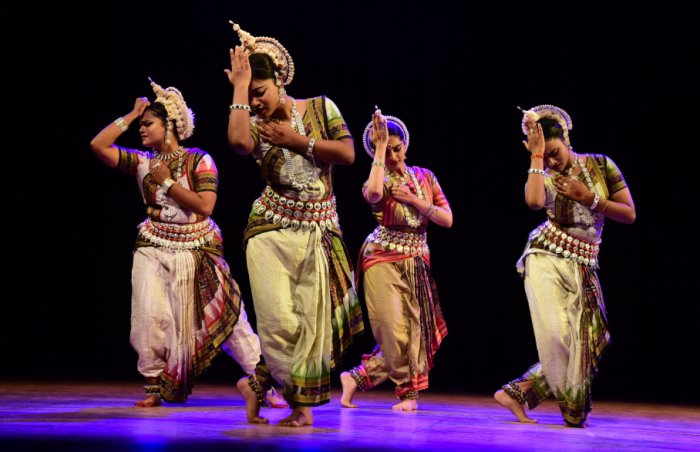 Duara Paka Nata The interesting story weaved around an annoyed Goddess Lakshmi, hurt on being left behind by her husband during the Ratha Yatra because of the Lord perhaps having another wife younger to her over there, thus accusing him of infidelity. Out of anger, Lakshmi throws tantrums, breaks a wheel of the chariot and pulls the robe of a priest. On Jagannath's return, Lakshmi allows only his brother and his sister to enter the temple and closes the door. In the verbal argument that follows, Lakshmi makes fun of Subhadra for being the daughter of the cowherd king and putting on airs like his brother. Jagannath tries to pacify his angry wife with jewels and pleads for forgiveness but at the same time reminds her that it was only a person like him who could tolerate such a temperamental woman like her. Anybody else in his place would have already worn a loincloth and become an ascetic. Lakshmi, feeling remorseful for her behavior, finally let Jagannath in and their patch up was celebrated joyously by everyone. The essence of common domestic quarrel or disagreement between spouses extended to Gods and Goddesses evokes interest and provides enjoyment to the humans, to that matter the audience and hence the sweet story rules the presentation and gives a boost to the music and dance. The songs were sung well in traditional tunes, especially "Suno Suno" by the dasis (female attendants) which remained pivotal in the production in communicating the series of incidents. Well synchronized dancing by skillful dancers and effective lighting added to the professionalism of the production although some parts of the choreography especially the entries and exits were repetitive. If, like the earlier production Meghadootam, there would have been paintings or pictures of sorts or at least an idol of the divine entities on the blank backdrop, the production would have acquired a special edge of interest and appeal. The research was by Prateek Pattanaik with music and rhythm by Ramesh Chandra Das, Prateek Pattanaik and Satchidananda Das. The choreography was by Ileana Citaristi and the dancers were Mousumi Mohapatra, Upasana Mohanty, Priyanka Sahoo, Kashish Bharati, Subhashree Mahapatra, Anwesha Padhi, and Subhashree Jaysingh. 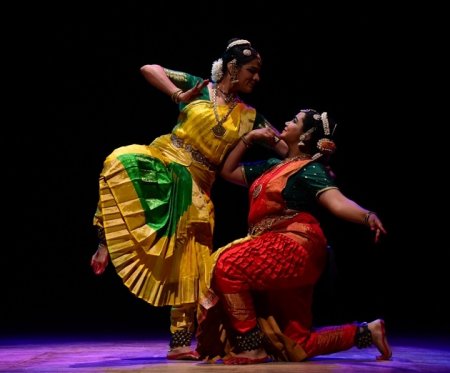 Navarasa Shakti The curtain came down with a riveting performance of 'Navarasa Shakti' by Anuradha Vikranth and Drishti Ensemble - a group that blends traditional with creative dance presentations. Navarasa Shakti was a depiction of nine moods or rasas with seven different mythological story lines from the life of the Devi. Soul stirring violin strokes, ringing of the brass bells and the sound of blowing conch shell ushered in the presentation while Anuradha and four dancers appeared on stage with the reverberation of the invocation "Om Sri Sri Tribhuvana Janani…. Rajeshwari Katyayani" followed by the chanting of the theme shloka "Navarasa Bakini Devi" and the performance space was filled with an amazing devotional fervour. Thus Anuradha prepared the audience to watch the Mother Goddess in her nine different moods. The colour of the costumes and effective light designing helped. The production commenced with Shringara (love), the most desirable of all rasas and was illustrated with the story of Parvati falling in love with the mendicant Shiva at first sight. This was followed by Veera - the heroic pride portrayed with the familiar story from 'Devi Mahatmyam' where Durga and her tiger kill the deadly demon brothers Shumbha and Nishumbha. Karuna was the compassionate Dakhshayini, who overcomes the humiliation and hurt provoked by Daksha's insults to Shiva for the sake of her sakhis and devotees. Hasya is seen in hilarious interactions and pranks of her playful sons Shanmukha and Ganapathi and was enjoyable. Bhibhatsa (disgust and aversion) was about Kali, the black one who brutally slays Raktabija and consumes his blood. A gruesome representation indeed! Raudra (anger) displayed the anger of Goddess Durga as 'Rudrapriyai Chandikeya' when invoked by the distressed Gods and Goddesses to contain the misdeeds of demon Mahishasura - a combination of asura (demon) and Mahisha (buffalo) - and was very vividly presented. Bhayanaka (fear) is seen in the Goddess when Lord Shiva opens his third eye and kills Manmatha and was hair-raising. In Adbhuta (surprise), Devi is a complete embodiment of creation, protection and destruction. This multidimensional form of womanhood strikes the hearts of the devotees with wonderment and awe. For Shanta (peace), Devi was represented in the form of Omkar! She is at peace when she has the whole world at peace. 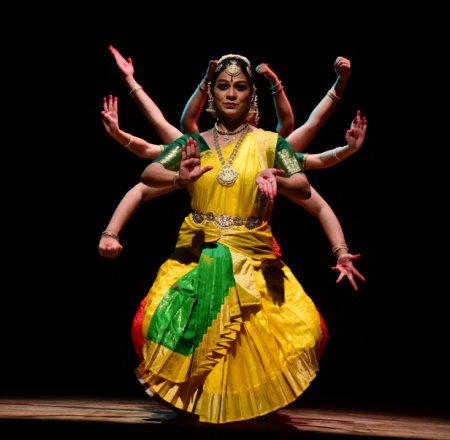 Navarasa Shakti The dances were set to songs in ragamalika, talam adi, often interspersed with the chanting of shlokas .The fine concept and visually impactful choreography with an amalgamation of perfectly executed jatis and sharp teermanams by Anuradha Vikranth deserved the ovation they received for their captivating performance. Wise use of stage space and harmonious teamwork by the highly professional dancers added brilliance to the production and so did the melodious vocal support and music composition by D S Srivatsa and Gurumurthy which contributed to the total impact of the presentation. The lyrics were by Shatavadhani Dr. R Ganesh. 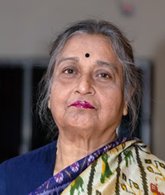 Dr. Nita Vidyarthi is a veteran critic of performing arts and writes on dance, music and theatre in leading publications. |